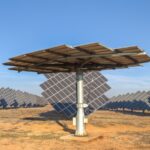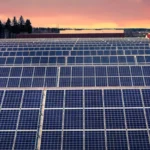Understanding Solar Cells and Modules: A Complete Guide
Understanding Solar Cells and Modules: A Complete Guide
With electricity bills rising and pollution increasing, more people are turning to the sun for clean, cost-effective, and unlimited energy. That’s where solar panels and solar cells were introduced, that turns sunlight into power you can actually use.
In this blog, we’ll learn about solar cells, what constitutes the solar panels, in the simplest way possible. From what a solar cell is and how it works, we’ll learn that this technology is changing the way we live, one rooftop at a time.
What is a Solar Cell?
A solar cell, popularly called a solar panel solar cell, converts sunlight into electricity. As the light hits the cells, it creates a small electric current, and a combination of such cells power houses and businesses.
In India, first generation solar panels are mostly used, such as monocrystalline and polycrystalline solar panels. But recently, high efficiency solar cells like bifacial solar cells are gaining traction because of their enhanced properties.
Panels made out of these high-performance cells use multi-busbar, passivated layers, or vertical bifacial design. These methods reduce energy loss and improve performance.
According to MNRE, India’s Grid-Connected Rooftop Solar Programme Phase II aims to increase demand for solar panels and solar systems.
How it Works
A solar cell turns sunlight into electricity. Each cell is made of silicon which absorbs light. As the sunlight is absorbed, particles called electrons go out, generating electric current behind them. This flow of electricity powers the home appliances.
Many of these solar cells connected, forming a solar panel. The amount of electricity produced is proportional to the amount of sunlight the panel gets. These panels are connected to an inverter which changes the direct current (DC) to alternating current (AC), which is used in homes and buildings.
There are two main ways to use this electricity, with on-grid solar systems or with off-grid solar systems.
Types of Solar Systems
There are main 2-types of solar systems that are installed, based on the type of setup and grid-distance from the site.
On-Grid Systems (Grid-Connected)
On-grid systems connect the solar cell and module setup directly to the electricity grid. If the energy consumption is less than the energy produced, then the unused energy is sent back to the grid through net metering.
This benefits the user, as they earn credits that cuts down on electricity expenses. This setup eradicates the use of battery storage, which makes it further cost-effective for urban and sub-urban installations.
Modern systems use bifacial solar cells or half-cut Mono-PERC for greater power input. With MNRE’s Phase II rooftop scheme, on-grid installations and rooftop solar adoption is increasing.
Off-Grid Systems (Standalone)
Off-grid setups store solar energy in batteries, which would be utilized in absence of sunlight. They are very common in remote areas, where grid access is limited.
These systems are more expensive comparatively, due to the need for battery storage. Cells like thin-film or polycrystalline are used on the basis of cost and availability, further adding it to the cost.
Most Prominent Types of Solar Cells used in India
The main three types of solar cell types that are preferred in India in 2025 are Monocrystalline Silicon, Polycrystalline, and Thin-Film Solar Cells. Let’s see their key features which make them remarkable.
Monocrystalline Silicon Solar Cells
- Known for their dark black colour.
- These cells lead the market with a 37-41% share in 2025.
- Provides 19-22% efficiency and long lifespan.
Polycrystalline Solar Cells
- Recognizable by their bluish color.
- These cost-effective cells hold around 22-25% market share.
- Provides 16-18% efficiency.
Thin-Film Solar Cells
- Lightweight and flexible
- Contribute to 10-12% of installations
- Provides 10-12% efficiency,
- Better for large, low-cost, or remote applications.
New technology has led to the innovation of dye-sensitized solar cells (DSSC), perovskite solar panels and organic photovoltaic panels, which fall under third generation solar panels. But bifacial and Mono-PERC panels offer higher yield and better performance in home installations.
Market analysis predicts that India will reach 73 GW of solar panel installations by 2033, growing 25% annually. Rooftop PV alone accounted for 17.7 GW by April 2025 out of the total capacity of 108 GW.
Recent Government Support & Market Trends in 2025
India is continuously expanding in its solar system sector, with the PM Surya Ghar: Muft Bijli Yojana. It offers up to ₹78,000 subsidy for residential solar (till 3 kW) and additional support for bigger systems in housing societies.

India’s total solar capacity is currently at 108 GW as of April 2025, with 17.7 GW contributions from the rooftop solar installations. Market analysts estimate that it may cross 60 GW by manufacturing capacity, by the end of this year.
Final Words
India’s solar market in 2025 is captured by monocrystalline, polycrystalline and thin-film solar cells. On-grid systems with net metering are preferable for homes, with bifacial variants, which offer best performance especially for rooftop solar users.
With a strong backbone of government solar subsidy schemes and programmes, solar installations are expanding exponentially. If you’re looking to switch to solar, Smart Roof Solar is here to help. With expert guidance, and top-quality service, renewable solar can be made affordable.
FAQs
Q1: Why Are Monocrystalline and PERC Preferred for Homes?
Ans: Monocrystalline silicon cells are preferred due to their high efficiency and compact size. They fit well on limited roof space and produce more electricity per square metre.
Q2: Can solar panels be made in different colors or transparent?
Ans: Yes, organic modern cells can be semi-transparent or colored for design use.
Q3: Are there solar cells that work indoors?
Ans: Yes, the organic and dye-sensitized solar cells can generate power from indoor light sources too.
Q4: Is there a solar cell that can be sprayed or printed?
Ans: Perovskite and organic solar cells can be made using printing or spraying, making them cheap and lightweight.
Suggested Articles

6 Innovative Applications of Solar Energy You Should Know About
Explore how solar energy is revolutionizing daily life and industries. From solar-powered transport to smart cities, discover six groundbreaking solar applications shaping a cleaner, smarter future.

Solar Energy for Petrol Pumps: Benefits, Savings, and Implementation
Petrol pumps can significantly reduce energy costs and carbon footprint by adopting solar power. This guide explains the benefits, types of solar installations, and how fuel stations can leverage renewable energy for sustainable and efficient operations.

Latest MNRE List: Approved Solar Module Manufacturers
Check the latest MNRE-approved list of solar module manufacturers to ensure quality and compliance for your solar projects in India.

Delhi Government Pledges to Boost Renewable Energy Generation
Delhi, the capital city of India, is moving towards a greener future with an ambitious plan to generate an additional 6,000 MW of electricity using renewable energy sources.

How to Clean and Maintain Solar Power System for Maximum Efficiency
Regular cleaning of your solar power system is essential to maintain maximum efficiency and energy output. Dust, bird droppings, and pollution can reduce performance by up to 20%. This blog explains the right cleaning methods, schedules, and safety tips for residential, industrial, and commercial solar systems.

What Is a Solar Power Generating System? | Complete Guide
A solar power generating system converts sunlight into electricity for residential, industrial, and commercial use. This blog explains the components, working, and benefits of solar systems, helping you understand how to harness solar energy efficiently and sustainably.

Solar Industry Faces Growing Losses from Underperforming Equipment
According to the Raptor Maps’ Global Solar Report, the amount of power loss due to equipment anomalies has nearly doubled from 1.61% in 2019 to 3.13% in 2022. This trend is expected to continue, with anomaly-driven power loss potentially growing to almost 6% by 2025.
Researchers Propose New Way to Make Nuclear Power Plants Safer
Researchers propose innovative methods to enhance the safety of nuclear power plants, aiming to reduce risks and improve operational security.